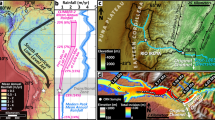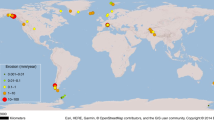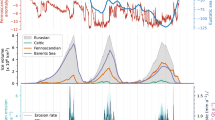Abstract
The potential link between erosion rates at the Earth’s surface and changes in global climate has intrigued geoscientists for decades1,2 because such a coupling has implications for the influence of silicate weathering3,4 and organic-carbon burial5 on climate and for the role of Quaternary glaciations in landscape evolution1,6. A global increase in late-Cenozoic erosion rates in response to a cooling, more variable climate has been proposed on the basis of worldwide sedimentation rates7. Other studies have indicated, however, that global erosion rates may have remained steady, suggesting that the reported increases in sediment-accumulation rates are due to preservation biases, depositional hiatuses and varying measurement intervals8,9,10. More recently, a global compilation of thermochronology data has been used to infer a nearly twofold increase in the erosion rate in mountainous landscapes over late-Cenozoic times6. It has been contended that this result is free of the biases that affect sedimentary records11, although others have argued that it contains biases related to how thermochronological data are averaged12 and to erosion hiatuses in glaciated landscapes13. Here we investigate the 30 locations with reported accelerated erosion during the late Cenozoic6. Our analysis shows that in 23 of these locations, the reported increases are a result of a spatial correlation bias—that is, combining data with disparate exhumation histories, thereby converting spatial erosion-rate variations into temporal increases. In four locations, the increases can be explained by changes in tectonic boundary conditions. In three cases, climatically induced accelerations are recorded, driven by localized glacial valley incision. Our findings suggest that thermochronology data currently have insufficient resolution to assess whether late-Cenozoic climate change affected erosion rates on a global scale. We suggest that a synthesis of local findings that include location-specific information may help to further investigate drivers of global erosion rates.
This is a preview of subscription content, access via your institution
Access options
Access Nature and 54 other Nature Portfolio journals
Get Nature+, our best-value online-access subscription
$29.99 / 30 days
cancel any time
Subscribe to this journal
Receive 51 print issues and online access
$199.00 per year
only $3.90 per issue
Buy this article
- Purchase on Springer Link
- Instant access to full article PDF
Prices may be subject to local taxes which are calculated during checkout




Similar content being viewed by others
References
Molnar, P. & England, P. Late Cenozoic uplift of mountain ranges and global climate change: chicken or egg? Nature 346, 29–34 (1990).
Raymo, M. E. & Ruddiman, W. F. Tectonic forcing of late Cenozoic climate. Nature 359, 117–122 (1992).
Berner, R. A., Lasaga, A. C. & Garrels, R. M. The carbonate-silicate geochemical cycle and its effect on atmospheric carbon dioxide over the past 100 million years. Am. J. Sci. 283, 641–683 (1983).
Kump, L. R., Brantley, S. L. & Arthur, M. A. Chemical weathering, atmospheric CO2, and climate. Annu. Rev. Earth Planet. Sci. 28, 611–667 (2000).
France-Lanord, C. & Derry, L. A. Organic carbon burial forcing of the carbon cycle from Himalayan erosion. Nature 390, 65–67 (1997).
Herman, F. et al. Worldwide acceleration of mountain erosion under a cooling climate. Nature 504, 423–426 (2013).
Zhang, P., Molnar, P. & Downs, W. R. Increased sedimentation rates and grain sizes 2–4 Myr ago due to the influence of climate change on erosion rates. Nature 410, 891–897 (2001).
Sadler, P. M. The influence of hiatuses on sediment accumulation rates. Geores. Forum 5, 15–40 (1999).
Schumer, R. & Jerolmack, D. J. Real and apparent changes in sediment deposition rates through time. J. Geophys. Res. 114, F00A06 (2009).
Willenbring, J. K. & von Blanckenburg, F. Long-term stability of global erosion rates and weathering during late-Cenozoic cooling. Nature 465, 211–214 (2010).
Herman, F. & Champagnac, J.-D. Plio-Pleistocene increase of erosion rates in mountain belts in response to climate change. Terra Nova 28, 2–10 (2016).
Willenbring, J. K. & Jerolmack, D. J. The null hypothesis: globally steady rates of erosion, weathering fluxes and shelf sediment accumulation during Late Cenozoic mountain uplift and glaciation. Terra Nova 28, 11–18 (2016).
Ganti, V. et al. Time scale bias in erosion rates of glaciated landscapes. Sci. Adv. 2, e1600204 (2016).
Reiners, P. W. & Brandon, M. T. Using thermochronology to understand orogenic erosion. Annu. Rev. Earth Planet. Sci. 34, 419–466 (2006).
Hurford, A. J. Uplift and cooling pathways derived from fission track analysis and mica dating: a review. Geol. Rundsch. 80, 349–368 (1991).
Stephenson, J., Gallagher, K. & Holmes, C. C. Low temperature thermochronology and strategies for multiple samples 2: partition modelling for 2D/3D distributions with discontinuities. Earth Planet. Sci. Lett. 241, 557–570 (2006).
Fox, M., Herman, F., Willett, S. D. & May, D. A. A linear inversion method to infer exhumation rates in space and time from thermochronometric data. Earth Surf. Dynam. 2, 47–65 (2014).
Fox, M., Herman, F., Willett, S. D. & Schmid, S. M. The exhumation history of the European Alps inferred from linear inversion of thermochronometric data. Am. J. Sci. 316, 505–541 (2016).
Seward, D. & Mancktelow, N. S. Neogene kinematics of the central and western Alps: evidence from fission-track dating. Geology 22, 803–806 (1994).
Fügenschuh, B. & Schmid, S. M. Late stages of deformation and exhumation of an orogen constrained by fission-track data: a case study in the Western Alps. Geol. Soc. Am. Bull. 115, 1425–1440 (2003).
Tricart, P., van der Beek, P., Schwartz, S. & Labrin, E. Diachronous late-stage exhumation across the western Alpine arc: constraints from apatite fission-track thermochronology between the Pelvoux and Dora-Maira Massifs. J. Geol. Soc. Lond. 164, 163–174 (2007).
Beucher, R., van der Beek, P., Braun, J. & Batt, G. E. Exhumation and relief development in the Pelvoux and Dora-Maira massifs (western Alps) assessed by spectral analysis and inversion of thermochronological age transects. J. Geophys. Res. 117, F03030 (2012).
Valla, P. G., Shuster, D. L. & van der Beek, P. A. Significant increase in relief of the European Alps during mid-Pleistocene glaciations. Nat. Geosci. 4, 688–692 (2011).
Fox, M., Herman, F., Kissling, E. & Willett, S. D. Rapid exhumation in the Western Alps driven by slab detachment and glacial erosion. Geology 43, 379–382 (2015).
Vernon, A. J., van der Beek, P. A., Sinclair, H. D. & Rahn, M. K. Increase in late Neogene denudation of the European Alps confirmed by analysis of a fission-track thermochronology database. Earth Planet. Sci. Lett. 270, 316–329 (2008).
Beaumont, C., Kamp, P. J. J., Hamilton, J. & Fullsack, P. The continental collision zone, South Island, New Zealand: comparison of geodynamical models and observations. J. Geophys. Res. 101, 3333–3359 (1996).
Batt, G. E. & Braun, J. The tectonic evolution of the Southern Alps, New Zealand: insights from fully thermally coupled dynamical modelling. Geophys. J. Int. 136, 403–420 (1999).
Batt, G. E., Braun, J., Kohn, B. P. & McDougall, I. Thermochronological analysis of the dynamics of the Southern Alps, New Zealand. Geol. Soc. Am. Bull. 112, 250–266 (2000).
Herman, F., Braun, J. & Dunlap, W. J. Tectonomorphic scenarios in the Southern Alps of New Zealand. J. Geophys. Res. 112, B04201 (2007).
Herman, F., Cox, S. C. & Kamp, P. J. J. Low-temperature thermochronology and thermokinematic modeling of deformation, exhumation, and development of topography in the central Southern Alps, New Zealand. Tectonics 28, TC5011 (2009).
Walcott, R. I. Modes of oblique compression: Late Cenozoic tectonics of the South Island of New Zealand. Rev. Geophys. 36, 1–26 (1998).
Ehlers, T. A., Farley, K. A., Rusmore, M. E. & Woodsworth, G. J. Apatite (U-Th)/He signal of large-magnitude accelerated glacial erosion, southwest British Columbia. Geology 34, 765–768 (2006).
Tippett, J. M. & Kamp, P. J. J. Fission track analysis of the Late Cenozoic vertical kinematics of continental Pacific crust, South Island, New Zealand. J. Geophys. Res. 98, 16119–16148 (1993).
Brandon, M. T., Roden-Tice, M. K. & Garver, J. I. Late Cenozoic exhumation of the Cascadia accretionary wedge in the Olympic Mountains, northwest Washington State. Geol. Soc. Am. Bull. 110, 985–1009 (1998).
Braun, J., van der Beek, P. & Batt, G. Quantitative Thermochronology: Numerical Methods for the Interpretation of Thermochronological Data (Cambridge Univ. Press, Cambridge, 2006).
Dodson, M. H. Closure temperature in cooling geochronological and petrological systems. Contrib. Mineral. Petrol. 40, 259–274 (1973).
Laslett, G. M., Green, P. F. & Duddy, I. R. Thermal annealing of fission tracks in apatite 2. A quantitative analysis. Chem. Geol. Isot. Geosci. Sect. 65, 1–13 (1987).
Mancktelow, N. S. & Grasemann, B. Time-dependent effects of heat advection and topography on cooling histories during erosion. Tectonophysics 270, 167–195 (1997).
Braun, J. et al. Quantifying rates of landscape evolution and tectonic processes by thermochronology and numerical modeling of crustal heat transport using PECUBE. Tectonophysics 524–525, 1–28 (2012).
Cressie, N. Statistics for Spatial Data (Wiley Interscience, Hoboken, 1993).
Farley, K. A. Helium diffusion from apatite: general behavior as illustrated by Durango fluorapatite. J. Geophys. Res. 105, 2903–2914 (2000).
Reiners, P. W., Spell, T. L., Nicolescu, S. & Zanetti, K. A. Zircon (U-Th)/He thermochronometry: He diffusion and comparisons with 40Ar/39Ar dating. Geochim. Cosmochim. Acta 68, 1857–1887 (2004).
Acknowledgements
We thank P. Valla for discussions on the topic. D. Jerolmack and A. Ault provided feedback on an early version of the manuscript. T.F.S. acknowledges support from the Emmy Noether Program of the Deutsche Forschungsgemeinschaft (DFG), grant number SCHI 1241/1-1, and the Helmholtz Association’s Initiative and Networking Fund. P.A.v.d.B acknowledges support from the Institut Universitaire de France (IUF). ISTerre is part of Labex OSUG@2020 (ANR10 LABX56). R.C.T. was funded by the DFG grant number TH 1371/5–1.
Reviewer information
Nature thanks R. Flowers, E. Kirby and J. Spotila for their contribution to the peer review of this work.
Author information
Authors and Affiliations
Contributions
T.F.S., P.A.v.d.B. and H.D.S. discussed early versions of the ideas presented here, which were refined following discussion among all the authors. T.F.S., P.A.v.d.B. and R.C.T. compiled data for the figures. T.F.S. and P.A.v.d.B. created all figures and constructed the edot2age.m Matlab script. P.A.v.d.B. carried out the synthetic model runs with the help of T.F.S. T.F.S., P.A.v.d.B. and H.D.S. analysed individual case studies. All authors discussed the results and contributed to the writing of the text.
Corresponding author
Ethics declarations
Competing interests
The authors declare no competing interests.
Additional information
Publisher’s note: Springer Nature remains neutral with regard to jurisdictional claims in published maps and institutional affiliations.
Extended data figures and tables
Extended Data Fig. 1 Empirical semi-variogram of erosion rates derived from AFT data from the European Alps.
a, Gamma plot, showing the mean of the squared differences (variance) in erosion rates for each distance bin. The plot shows a negative exponential pattern, as described in ref. 18. The variance at a distance of zero, defined as the ‘nugget’, is non-negligible. The nugget is considered to represent the measurement error plus the variance at distances smaller than the smallest measurable distance40. The ‘sill’ is the relatively steady variance value reached at distances beyond the initial increase40. The nugget-to-sill ratio, which in this case is about 0.35, indicates that approximately 35% of the variance is unaccounted for with the spatial correlation function40. b, Box plot of the range of squared differences in erosion rates, with boxes outlining quartiles of data, and error bars corresponding to 1.5 times the inner quartile distance. Horizontal lines within boxes show medians of data within each distance bin.
Extended Data Fig. 2 Global coverage and inferred cause of resolved changes in late-Cenozoic erosion rates.
The data are based on the inversion results of ref. 6. Locations where erosion rates are resolved both from 2–0 Myr ago and from 6–4 Myr ago are shown with thin black circles, whereas locations where erosion rates are resolved in all four 2-Myr time bins between 8 Myr ago and the present are shown with thick black circles. Circles filled with multiple colours indicate contributions from multiple factors.
Extended Data Fig. 3 Synthetic test for the western Alps.
a, Input exhumation rates are 1 mm yr−1 in the external zone and 0.25 mm yr−1 in the internal zone; they are held constant for 20 Myr. b, Predicted thermochronological ages; different symbols for thermochronological systems and colour scale for ages are as in Fig. 3a. c–e, Predicted erosion rates for a correlation length (λ) of 30 km from 6–4 Myr ago (c), from 2–0 Myr ago (d), and normalized difference in erosion rates from the comparison of c to d (as defined in equation (1)), shown only where the resolution in each time bin is greater than 0.25 (e). Contours in c–e show the predicted resolution. f–h, Same as c–e, but for a correlation length of 10 km. Ma, million years ago.
Extended Data Fig. 4 Overview map of the South Island, New Zealand.
Circles are locations where erosion rates are resolved (resolution >0.25) from both 2–0 Myr ago and from 6–4 Myr ago from the extended data of ref. 6. Black boxes outline the regions described in the case studies of Mount Cook (Fig. 4), Fiordland (Supplementary Fig. 8) and Marlborough fault system (Supplementary Fig. 16).
Extended Data Fig. 5 Synthetic test for the Mount Cook region in New Zealand.
a, Input exhumation rates are predicted from a kinematic model of overthrusting along a fault with a ramp–flat geometry30; rates vary from 2.2 mm yr−1 adjacent to the fault to zero far from it, and they are held constant for 10 Myr. b, Predicted thermochronological ages; different symbols for thermochronological systems and the colour scale for ages are as in Fig. 4a. c–e, Predicted erosion rates for a correlation length of 30 km from 6–4 Myr ago (c), from 2–0 Myr ago (d), and normalized difference in erosion rates from the comparison of c to d (as defined in equation (1)), shown only where the resolution in each time bin is greater than 0.25 (e). Contours in c–e show the predicted resolution. f–h, Same as plots c–e, but for a correlation length of 10 km.
Extended Data Fig. 6 Synthetic test for the Wasatch Mountains.
a, Input exhumation rates increase smoothly from zero at the eastern boundary to 1.2 mm yr−1 at the western boundary and are held constant for 12 Myr. b, Predicted thermochronological ages. Symbols for thermochronological systems and colour scale for ages are as in Supplementary Fig. 1a. c–e, Predicted erosion rates for a correlation length of 30 km from 6–4 Myr ago (c), from 2–0 Myr ago (d), and normalized difference in erosion rates from the comparison of c to d (as defined in equation (1)), shown only where the resolution in each time bin is >0.25 (e). Contours in c–e show the predicted resolution. f–h, Same as c–e, but for a correlation length of 10 km. i–k, Same as f–h, but for a prior erosion rate (ep) of 0.1 mm yr−1 instead of 0.35 mm yr−1.
Supplementary Information
Supplementary Information
This file contains the regional summaries and the Edot2age Matlab script. For each of the regions with erosion histories that are purportedly well resolved by the 1D inversion performed by ref. 6 (32 regions in total, 30 of which show accelerations), we present a literature review to compare the original data and interpretations to the erosion-rate histories reported in ref. 6. The Matlab script was used to determine what thermochronologic age corresponds to a given 1D steady exhumation rate with assumed crustal and thermal properties
Rights and permissions
About this article
Cite this article
Schildgen, T.F., van der Beek, P.A., Sinclair, H.D. et al. Spatial correlation bias in late-Cenozoic erosion histories derived from thermochronology. Nature 559, 89–93 (2018). https://doi.org/10.1038/s41586-018-0260-6
Received:
Accepted:
Published:
Issue Date:
DOI: https://doi.org/10.1038/s41586-018-0260-6
This article is cited by
-
Increased erosion of high-elevation land during late Cenozoic: evidence from detrital thermochronology off-shore Greenland
Scientific Reports (2022)
-
Nonlinear forcing of climate on mountain denudation during glaciations
Nature Geoscience (2021)
-
The impact of glaciers on mountain erosion
Nature Reviews Earth & Environment (2021)
-
Steady erosion rates in the Himalayas through late Cenozoic climatic changes
Nature Geoscience (2020)
-
Spatio-temporal variation in rock exhumation linked to large-scale shear zones in the southeastern Tibetan Plateau
Science China Earth Sciences (2020)
Comments
By submitting a comment you agree to abide by our Terms and Community Guidelines. If you find something abusive or that does not comply with our terms or guidelines please flag it as inappropriate.



